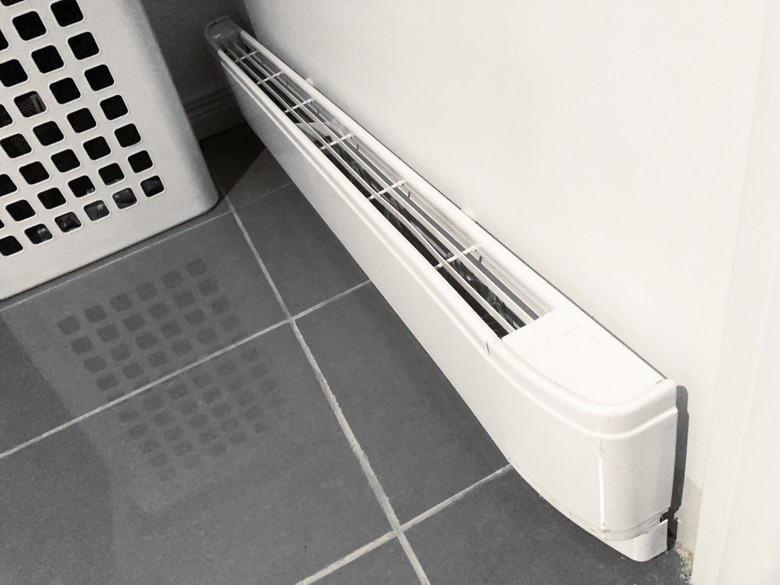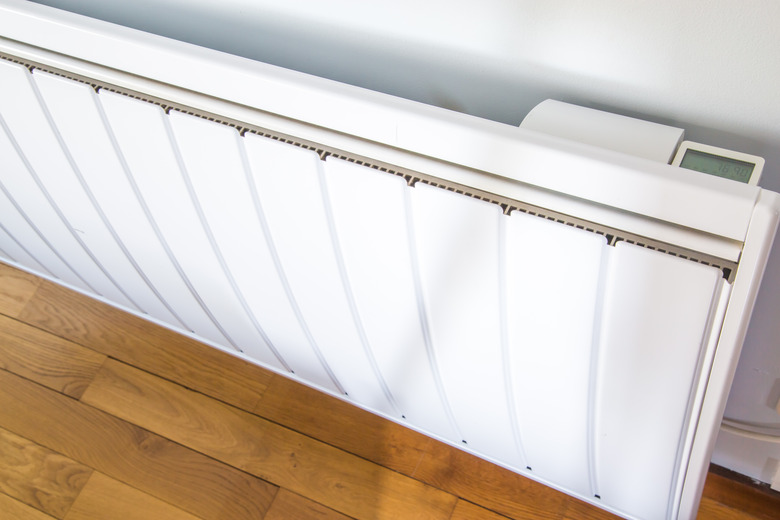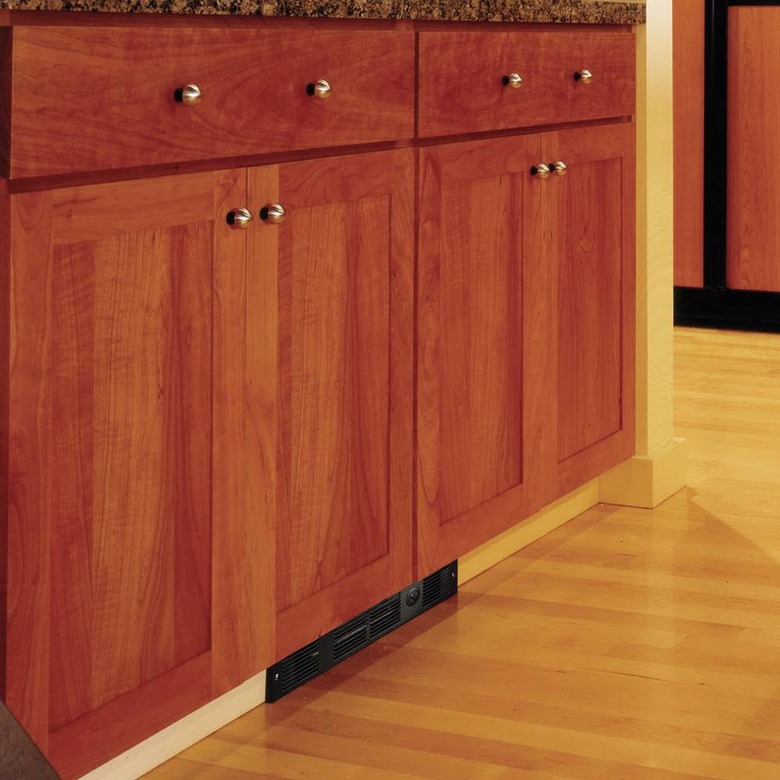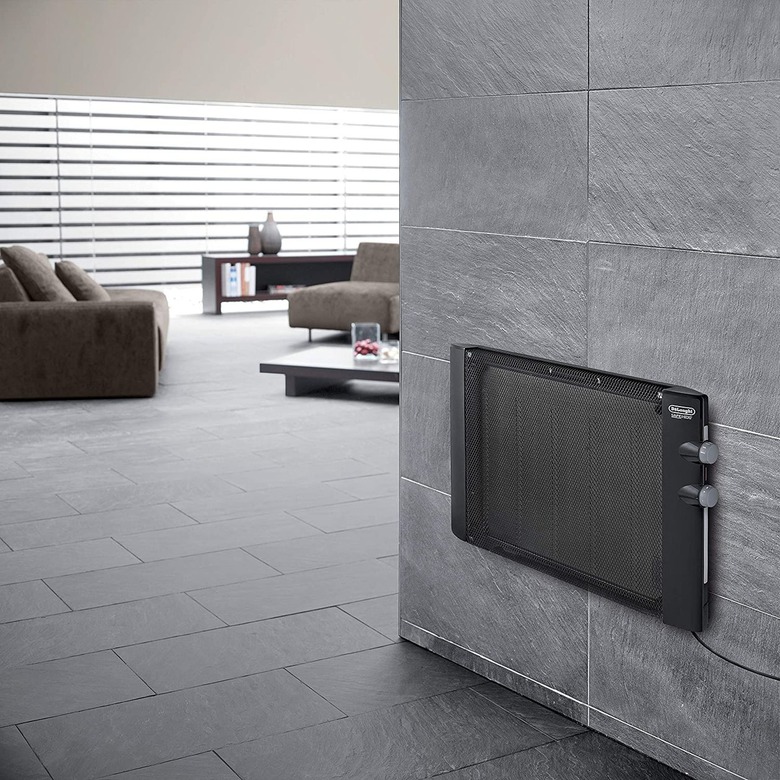6 Types Of Electric Heaters For Your Home — And Where To Use Them
We may receive a commission on purchases made from links.
Homeowners looking for quick heating solutions typically turn to electric heaters because they are inexpensive, easy to install, and have little to no effect on air quality. Unfortunately, the high cost of electricity as an energy source for home heating usually rules out electric heaters for whole-house heating, although in places without access to natural gas, propane, or heating oil, electricity may be the only practical option. Typically, however, electric heat usually takes a supporting role in parts of the house that don't get enough heat from a central heating system, and that's probably the most economical and efficient way to use it.
Looking to install electric heaters to create more warmth in your home? There are plenty of options to choose from — ranging from permanently installed to plug-in units to suit every heating scenario.
1. Electric Baseboard Heaters
1. Electric Baseboard Heaters
A home that relies exclusively on electricity for heat will often have at least some permanently installed and hardwired electric baseboard heaters, and plug-in portable units are also available for installation in a particular room. Hardwired units typically operate at 240 volts, which allows the units to draw more current and get hotter, while plug-in models operate at 120 volts. The wattage of a baseboard heater is calculated by the foot, with 225 watts per foot being typical, and the total power draw can be as much as 4,000 watts to heat an extra-large, 450-square-foot room. The output is controlled by a thermostat, which may be mounted on the front of the heater or on the wall.
An electric element runs the length of the heater and is enclosed by metal tubing that acts as a heat exchanger. Hot air naturally rises from the top of the heater, and cold air is drawn in from below, creating a convection current that gradually warms the room. Because they heat air from the ground up, baseboard heaters can make a room very comfortable, but they have a few drawbacks:
- The space in front of the heaters has to be kept clear. You can't put furniture there, and you can't hang draperies over the heaters.
- It takes a long time for the room to get warm, so you have to keep the heaters on rather than cycling them on and off, which would save energy.
- They get very hot and aren't suitable for houses with small children and pets.
2. Built-In Wall Heaters
2. Built-In Wall Heaters
Electric wall heaters come in a variety of modalities, and there is one for every space. Some are convection heaters that work much like baseboard heaters, allowing air to circulate around a heating element, discharging warm air from the top and pulling in cool air from the bottom. Panel heaters are one type that offer the advantage of remaining cool to the touch, making them safe for most situations.
Most other types of convection wall heaters employ fans to circulate the air, and one of the top-rated ones, the Stiebel Eltron 074057, operating at 240 volts and drawing 2,000 watts, can heat up a medium- to large-size room. The Cadet CEC163TW is the same type of heater that can operate at either 120 or 240 volts and has three power settings — 1,000, 1,500 and 1,600 watts — making it more economical to run.
One of the problems with fan heaters is that they make noise — not a lot but enough to be noticeable. Most of these are designed to mount on the surface of the wall, but some are inset, so installation requires cutting a hole in the wall.
3. Radiant Cove Heaters
3. Radiant Cove Heaters
Unlike convection heaters, radiant heaters heat objects in the path of the heater rather than the air, and while radiant heat is comfortable and instantaneous, you have to be in the path of the heater to feel it. One way to get the benefit of radiant heat in an entire room is to install a radiant floor heating system, but it's much easier and less expensive to install cove heaters, which are designed to fit in the corner made by the wall and the ceiling. This placement keeps the heaters out of the way of furniture and people, and because the heaters are angled toward the floor, they make heat available in every part of the room.
Cove heaters come in lengths from 24 to 118 inches and can operate at 120, 208 and 240 volts, with each unit drawing 250 to 1,800 watts. They are typically hardwired and can be wired from either end, making installation similar to wiring a light fixture. Cove heaters can be controlled by a thermostat that can be programmed to turn on the heat only at times of the day when it's needed.
4. Toe-Kick Heaters
4. Toe-Kick Heaters
Kick-space heaters, otherwise known as toe-kick heaters, offer another space-saving option for rooms with cabinets that have toe-kicks, which are recessed areas between the bottom of the cabinet doors and the floor. Heaters designed to fit in this space are shaped like shallow, rectangular boxes, and they work by convection, drawing cool air in from the floor, circulating it past an electric heating element and expelling it through a grid incorporated into the toe-kick. The heat is felt primarily at floor level, but it eventually rises to other parts of the room.
A toe-kick heater is designed for supplemental heat and won't keep a room warm by itself, so it is often used in conjunction with a central air system. Units typically operate at 120 volts and consume 1,000 watts, and because they are designed to go under a cabinet, installation involves some disassembly of the cabinet.
5. Micathermic Panel Heaters
5. Micathermic Panel Heaters
One of the most recently developed types of electric heaters, micathermic panels are flat and extremely thin, and most models can either be mounted on the wall or used as freestanding heaters. The heating elements are embedded in mica, a natural mineral, and when the mica heats up, it creates a convection current and at the same time radiates heat into the room. This is due to the fact that mica, besides providing thermal insulation for the heating elements, is mildly electrically conductive.
Micathermic panels are so energy efficient that they can heat a room using a fraction of the power used by other types of heaters. The EconoHome wall-mount panel heater, which comes with its own thermostat, operates at 120 volts and draws only 400 watts. Other models, however, such as the De'Longhi micathermic panel heater, draw 1,500 watts just like most other electric heaters, but unlike most other types of electric heaters, micathermic heaters can't overheat and start a fire.
6. Portable Space Heaters
6. Portable Space Heaters
When they need heat in a hurry, most homeowners will run out and purchase an electric space heater, and there are many types of space heaters from which to choose. Although space heaters can be dangerous if used improperly, they can create a warm, cozy room quickly — which can be very appealing during the coldest winter days.
Most have fans to distribute the heat generated by the heating elements, and while few are good for large spaces, most can handle small to midsize rooms. You can even find infrared heaters for outdoor use; you'll stay warm as long as you remain in the direct path of the heat being radiated by the heating element.
Space heaters plug into a 120-volt receptacle and typically draw 1,500 watts, although some have eco settings that draw less power. Portability is a significant asset; you can move portable heaters at will to wherever you need heat. You can even purchase a miniature one to set on your desk to keep your fingers warm while you type, but beware — some of those tiny heaters draw as much power as the larger ones that stay on the floor.
As a rule, electric space heaters only provide heat as long as the power is on, but oil-filled radiators are an exception. Instead of warming the air, the heating elements heat the oil in the radiator, and when it gets hot, it radiates heat and will continue to do so after you turn off the heater until the oil cools. These heaters get very hot to the touch, however, so they aren't safe to use when children are around unless they are well protected.
Just Know — Electric Heaters Can Be Expensive
Just Know — Electric Heaters Can Be Expensive
Virtually all electric heaters generate heat by electrical resistance — a notable exception being a heat pump, which transfers heat from outdoors by means of refrigeration coils — but they differ in the way they distribute the heat. Some heaters, such as baseboard or freestanding or wall-mounted panel heaters, create convection currents, while others, such as cove heaters and exposed-element space heaters, radiate heat directly into the room, warming objects in the path of the heater but not the air. Either way, the heat comes from glowing-hot heating elements.
Heating elements are poor electric conductors, and the resistive glow would be considered wasted electricity if the main purpose of the elements was to transmit electricity, but the glow is what a heater element is all about, and the hotter the element glows, the more energy it consumes in terms of electrical power, which is what consumers pay for. Electric heaters typically draw between 0.8 and 1.5 kilowatts, and some draw quite a bit more. According to the U.S. Energy Information Administration, the average consumer pays almost 14 cents per kilowatt-hour, and some pay 23 cents or more. That means it costs between $1.68 and $2.76 or more to run a 1,500-watt electric heater for an eight-hour period, which can definitely add up.
Some of the most efficient electric heaters minimize the power draw of the heating element by providing better heat distribution, and they often employ a fan that also draws power, although much less than the heating elements. Some micathermic wall panel heaters, which function both as convection heaters and radiant heaters and don't have fans, can heat a 120-square-foot room using just 400 watts (according to manufacturer claims), but low power draws like that are far from the rule. Ceramic and exposed-element space heaters may have low output settings that draw 800 or 1,000 watts, but when you set them on high heat, they draw 1,500 watts. The same is true for most other radiant and convection electric heaters. All in all, you're looking at an added expense if you plan on installing any type of electric heating system in your home.





